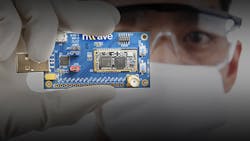First Development Kit Released for Weightless-N Wireless Standard
The Weightless SIG has released the first software development kit (SDK) for low-power wide-area networks (LPWAN) based on the Weightless-N wireless standard for Internet of Things (IoT) and M2M technologies. Earlier this year, the Weightless-N standard was introduced to support one-way communications between IoT terminals and base stations at low data rates.
The development kit provides a complete environment for developers to integrate LPWAN wireless connectivity into low-power IoT devices. Incorporating an ARM Cortex-M3 microcontroller with 128 Kbytes of flash memory, the SDK includes a desktop base station that imitates the functionality of a commercial-grade base station, a base-station antenna, module antenna, and full set of cabling. It also features an end-product module, which is mounted on a development board with external connections. Weightless SIG also includes software tools Simplicity Studio and a GNU C Compiler (GCC).
The Weightless-N network architecture operates over ultra-narrowband frequencies to increase signal propagation to almost 5 kilometers in urban environments. Weightless-N networks are typically deployed in the sub-GHz spectrum, occupying the industrial, scientific, and medical (ISM) bands. The standard employs a differential binary-phase shift-keying (DBPSK) digital-modulation scheme, while using a frequency-hopping algorithm to mitigate interference and bolster security.
The Weightless SIG has developed other wireless standards for low-power IoT and M2M devices. In August, the organization released the Weightless-P open standard, targeting bidirectional communications for terminals in the Industrial IoT (IIoT). Based on technology from M2Communication (M2COMM), it operates in the sub-GHz spectrum using FDMA/TDMA modulation in 12.5 KHz narrowband channels. On the other hand, the SIG’s Weightless-W standard is designed to operate in the television “white space” spectrum.
The tendency for IoT is a large number of devices that transmit small amounts of data to the same access point, according to Fabien Petitgrand, a technical staff member at M2COMM, in a presentation at last year’s ARM Tech Symposia. He cites low-power, low-cost, and highly reliable connections as the main requirements for these ultra-large networks. In the presentation, he stressed that cellular networks are not suited to these parameters. The Wi-Fi spectrum is overcrowded, mesh networks can not scale efficiently, and both consume too much power.
Following these trends, the Weightless SIG has taken the stance that a wide area of network coverage is more important to IoT and M2M communications than high data rates. While local area networks (WLANs) are expected to have a critical role in the IoT ecosystem, the SIG states that the “islands of coverage” provided by these short-range networks are not suitable for many IoT deployments. These include IoT networks geared for the industrial, healthcare, smart grid, and automotive fields—all of these applications will depend on large numbers of remote, battery-powered sensors.
The low frequency signals used by the Weightless-N standard satisfy the low-power requirement for IoT networks. With low frequency signals, network operators are able to design smaller, lower-power, and lower-cost antennas. This is especially important for IoT and M2M terminals, in which most of the functionality is handed off to the LPWAN network, according to the Weightless SIG. The organization’s website states that terminals operating with the Weightless-N standard can have a 10-year battery life from an AA-size battery.
The SDK is available at cost through NWave Technologies. However, the Weightless SIG is making a limited number of the development kits available to its members at no cost. Development kits for the Weightless-P open standard, which is geared specifically to IIoT networks, are scheduled to be released in the first quarter of 2016.
About the Author
James Morra
Senior Editor
James Morra is the senior editor for Electronic Design, covering the semiconductor industry and new technology trends, with a focus on power electronics and power management. He also reports on the business behind electrical engineering, including the electronics supply chain. He joined Electronic Design in 2015 and is based in Chicago, Illinois.

